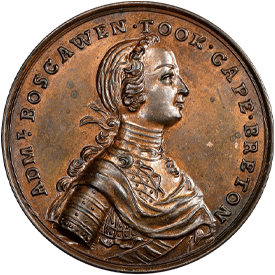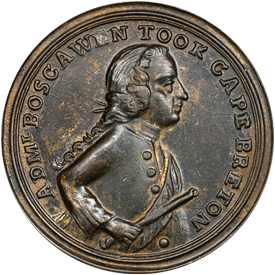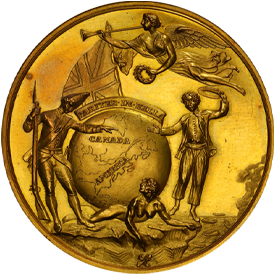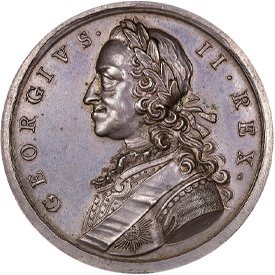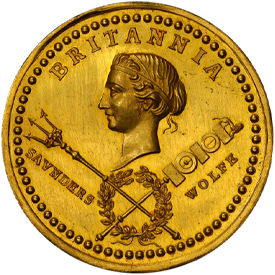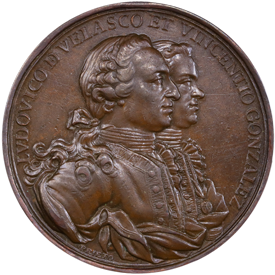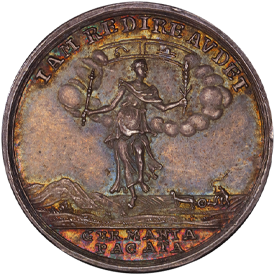After the period of colonization had ended in America, wars began to break out within the colonies. These wars are referred to at the Intercolonial Wars. It isn’t that the colonies hated each other, but the French, English, and Spanish governments were encouraging their colonies to take over more land and possessions. That led to fighting across the pond. These medals were produced to commemorate the spoils that were taken on expeditions into other colonies. A lot of these medals will be celebrating specific Generals and leaders, as well as the event. The events celebrated are often shown on the reverse.
The Franco-American Jetons of Louis XV that are featured in this category are divided into two main types: the first is used as a form of trade between the American colonies and France and were produced to evoke the sense of prosperity in the New World. The second type was designed to speak more to the goals of France in the New World. These would include conquest to gain new land and to dominate the American continent. These Jetons were produced annually, beginning in 1751 and ceased production after the French were defeated by the British in Canada a number of years later.
Great Britain, on the other hand, infrequently produced medals that symbolized or showed the colonist. Many of the English medals were centered around presentations to the Native Americans and around the exploits of the new world. The approach to these two medals by these two countries is much different. France showed colonist who loved and supported the mother-country. Great Britain showed riches because their colonist were unhappy. The book by Charles Betts, American Colonial History Illustrated By Contemporary Medals (1894), probably says it best: "the English Colonist always dreamed of independence; the French never.The Medals described in this Chapter abundantly confirm this view."
King George's War
From an American perspective, the period of King George’s War offers just one medallic memorial of particular note, the 1746 Annapolis Tuesday Club medal. There are no medals struck in this period that commemorate or otherwise acknowledge any of the land campaigns in North America or even any of the naval engagements that disturbed colonial trade at the time.
This lack of medallic tribute is all the more surprising given the rather desperate nature of some of the battles and the importance of their outcomes for the future on the continent. One might have thought that the siege and capture of Fortress Louisbourg by a combined colonial army and homeland navy would have occasioned a series of medals struck in honor of the event. Unfortunately, such was not the case. The prize was returned to France by the terms of the Treaty of Aix-la-Chapelle only to be recaptured a decade later.
Medals for Anson’s circumnavigation of the globe have only a peripheral l'elevance to North American history. Capture of the plate fleet two years earlier, in 1745, had nothing to do with North American history and only justify its medallic presence in Betts by expediently pretending that “America” really includes both continents in the western hemisphere. The 1748 Compagnie des Indes medal are French jetons struck for local consumption in a provincial town. On the other hand, the medals struck to commemorate the peace treaty that ended the war are legitimate “American” collectables since they did mark an ending to one phase of the imperialist struggle to control North American commerce.
The French and Indian War
When it became clear to the European powers that the stalemate of the previous war was likely to be repeated when dynastic ambitions once again turned to warfare for their achievement, French and English planners looked to the North American continent for fresh fields on which to play out their games of conquest. That the contest would be uneven right from the beginning could not have been hard to imagine and while the belligerents might be evenly matched on the European field, English power was more readily projected overseas. The French and Indian War was a replay of King George’s War with outcomes inevitably similar.
The medallic history of the war is far richer than that of any other conflict on North American soil and of any in which the later government of the United States participated until the American Civil War. The majority of the medals struck during this period that reflect events in the war of significance to North America were English. The few French medals made at this time reflect the unhappy fortunes of French arms during the war.
Unlike King George’s war, which was entirely lacking in medallic tributes to important military engagements in North America, the English took care to note in medallic form the fall of many important towns and forts.
The final capture of Fortress Louisbourg saw a series of major medals struck for the occasion. The falls of Oswego, Frontenac, and Niagara were jointly noted on a series of medals while the capture of the island bastion of Guadeloupe and the siege of Morro Castle in Havana saw medals made by several engravers for public sale including the sole medal made by Spain. The death of General Wolfe and the capture of Quebec and Montreal, followed by the surrender of French forces in Canada, were all commemorated on medals.
The single most significant development of this period in the medallic history of the wars on the North American continent is the appearance of medals designed, engraved, and struck locally in honor of local military accomplishment. Chief among these are the 1756 Kittanning Destroyed medal and the series of medals made for presentation to agreeable native American leaders. These medals seem to mirror in their own way the growing confidence in their own abilities that was the single most important outcome for European residents of British North America of the French and Indian War. Self confidence, a new sense of their identity as different from those in the homelands they had left, and the relaxation of the stress generated by living close to a neighbor whose ambitions were hostile to their own, all led the newly self-aware Americans to the inevitable break with the homeland that would come just a bit more than a decade later. In their own ways, the medals made by Americans for Americans reflect this trend.
The Period of Intercolonial Wars Betts Medals include Betts-381 to Betts-447.
















